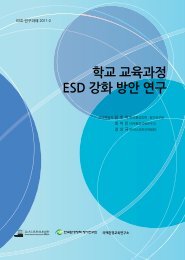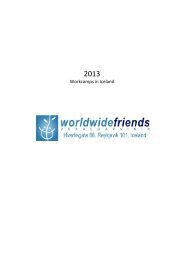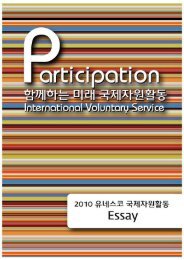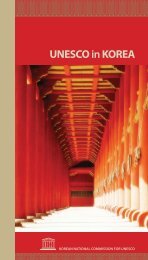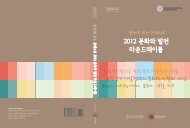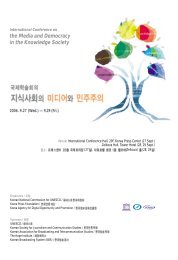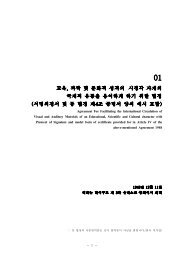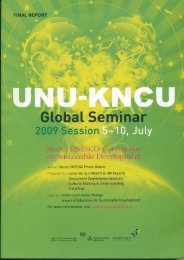Untitled
Untitled
Untitled
You also want an ePaper? Increase the reach of your titles
YUMPU automatically turns print PDFs into web optimized ePapers that Google loves.
3. Creativity, Education and Green Talent<br />
a. Why Creativity?<br />
The future oriented green growth model urges for the reform of talent and the<br />
human resources paradigm. If the core competency of a talent in the past industrial<br />
society was how to efficiently solve a given problem, the core competency of a<br />
talent in this new green growth paradigm is creativity, which is to create new things,<br />
doubt and question the existing paradigm and turn the premise upside down. Such<br />
capability was also required in post-industrial and knowledge based society,<br />
however, it has become a much more critical quality to become a talent that leads<br />
the new paradigm of green growth. Particularly, the creativity that is developed<br />
during youth is a basic qualification for nurturing talents as green technology and<br />
science technology human resources. In addition, since creativity can be revealed in<br />
diverse areas, creative talents can be nurtured in diverse areas as well, thereby<br />
utilizing talents efficiently.<br />
Creativity is needed in all stages of life, and it can also be partly learned,<br />
particularly during early childhood and youth. Despite a consensus that creative<br />
talent is necessary, issues on what is creativity, who is creative talent and how they<br />
are raised is still being discussed in diverse ways without any agreed answers.<br />
Generally, the dictionary defines creativity as “capability of creating or discovering<br />
new things” and as the abililty to think differently and solve problems in different<br />
ways. Something that is “new” and “different” are important elements of creativity,<br />
however, utility and appropriacy, which are related to problem solving ability is also<br />
important. An idea should be new and to utilize this idea, a problem solving ability is<br />
needed as well.<br />
b. Creative Education System<br />
The definition of creativity is still open and there are many arguments on how<br />
to nurture creativity. However, creativity based on self thinking and a culture that<br />
allows the failure of diverse experiments and problem solving skills should all be<br />
emphasized in order to develop creative talents. Statistical numbers indicate that the<br />
current formal and potential curriculm in Korea does not promote creativity. Results<br />
from international academic achievement tests from PISA and TIMSS show that<br />
Korean students (age 15) are beyond the average of other OECD countries, but the<br />
learning efficiency index shows that Korea is far below that of Japan or Finland who<br />
have high academic achievement just as Korea does. For example, Finland has a<br />
similar level of academic achievement as Korea, but they spend only two thirds of<br />
the study time of Korean students. Also, Japan, even though they score slightly<br />
lower than Korea, spends 30% less studying time than Korean students. Therefore,



